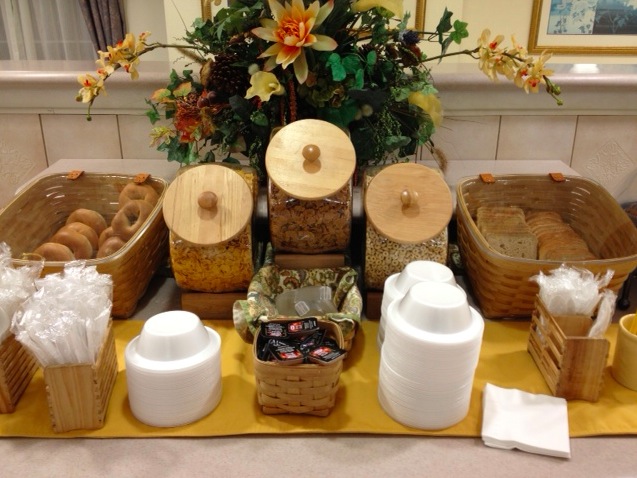What's for breakfast?

We've all heard since we were pouring Frosted Flakes into a plastic bowl and drinking the chocolately milk after a helping or three of Chocolate Rice Krispies: "Breakfast is the most important meal of the day." But what was not drilled into us, was why it was so important. A good breakfast sets the stage for a great day: energy, low cravings/hunger, keeping our metabolism steady. A bad one (exhibits A and B above) will ruin your entire day by allowing insulin to spike and set you on a course for fat storageville and sluggishness.
What you choose to eat upon getting out of bed sets the stage for the rest of the day. On center stage is insulin. A hormone secreted by the pancreas in response to the amount of glucose (sugar) you just consumed and how quickly it is absorbed into your bloodstream (known as the glycemic index). The more processed (cereal grains/flour) or free-form (added sweeteners) the meal you consume is the higher the insulin spike from the pancreas.
Insulin was a great hormone when we were hunters and gatherers, often eating every 3-4 days. When we had our meal, insulin helped to store the energy as fat so that we could parcel it out over our several day starvation and still thrive. Not only that, it increased cravings so we could eat a bit more and potentially have reserves to go 5 or 6 days. In addition, insulin stimulates a couch potato cloudiness that keeps us from being very active (why burn up all that energy right away?).
Now insulin, while essential for life, appears to be a major enemy to our waistlines and overall health. So keeping insulin low, especially to start the day is key.
As I have begun more and more to preach against grains and advising patients to globally lower them, one of the common responses I get is, but my cereal is high-fiber. Now, just because it says "high-fiber" on the box does not mean it's really high fiber. Most of the ones people opt for have 15-25 grams of sugar from several different sources. A true high fiber cereal should have more fiber grams than sugar grams and the greater disparity the better.
So what about that high fiber cereal? It's better than Frosted Flakes, but does that make it a good choice in the morning? A study from 2008 pitted a breakfast of high fiber cereal versus a low glycemic index breakfast. Remember, the glycemic index gauges the rise in glucose into the bloodstream from a meal and therefore the resultant rise in insulin. An example of a low glycemic breakfast would be one largely protein based (think eggs or whey protein), moderate whole fruit, unsweetened plain yogurt, cottage cheese, low in all grains.
The results over 6 months are quite substantial. Look at the curves of both body weight and hemoglobin A1C (average blood sugar). Even eating high fiber cereal grains do not appear to be the best strategy.(1,2)

In addition, a study from 2011 that showed the higher percent of protein one eats in the morning, the less calories they consume the rest of the day.(3) So rethink your morning routine. The bowl of cereal grains or even oatmeal with orange juice is likely to promote hunger sooner in the day and drive the insulin response, promoting foggy brain and fat storage.
What about our new food pyramid/plate/chart showing grains as a substantial part of the diet. Maybe some brown rice or quinoa later in the day, but not for breakfast. Even one of the "Powers That Be" in the dietary world, the American Diabetes Association Journal recently published, "Nuts as a Replacement for Carbohydrates in the Diabetic Diet".(4) The perfect vote of support for the new Grain-Free Granola I've been enjoying every now and then with unsweetened almond milk, along with a version we're making from scratch at home. Recipe to come in a future post.
My current favorite breakfasts:
Take organic spinach and place in a freezer bag and freeze overnight. The more you store the more you will have for subsequent breakfasts. Once frozen, squeeze the bag to break up the spinach into small pieces. This also works great for kale and collard greens.
Saute 1/2-1 cup of "minced spinach" in grassfed butter, coconut oil or olive oil (over medium heat)
Add 2-3 farm fresh eggs
Add 2-3 tbsp of salsa (choose one that has no added sugar)
Add 1/4-1/3 cup of frozen green peas
In a pinch, this also works well in a glass bowl and microwaved. I put it in for 1:45 and then take it out and stir it up, placing it back in for 45-60 seconds.
OR
1-1.5 scoops unsweetened whey protein from grassed cows
1-2 tsp cinnammon
1/4 cup walnuts
1/3-1/4 banana
2-3 oz of crushed ice
6-8 oz of water or unsweetened almond milk
I use a Cuisinart hand blender, but any blender will due.
References:
1. Jenkins DJ, al: Effect of a low-glycemic index or a high-cereal fiber diet on type 2 diabetes: a randomized trial. JAMA 2008,300(23):2742-2753.
2. http://rdfeinman.wordpress.com/2012/01/03/slouching-toward-low-carb-we-thought-of-this-first/
3. Gosby AK, Conigrave AD, Lau NS et al. Testing protein leverage in lean humans: a randomised controlled experimental study. PLoS One 2011;6:e25929. doi: 10.1371/journal.pone.0025929
4. Jenkins DJ, et al: Nuts as a replacement for carbohydrates in the diabetic diet. Diabetes Care 2011, 34(8):1706-1711.
Contributed by:
Dr. Jeffrey Gladd
Owner
Dr. Jeffrey Gladd graduated from Indiana University School of Medicine in 2001. He then went on to train in family medicine...
View Full Bio »

